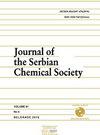不同溶剂法制备蜂胶提取物的化学成分及抗诱变活性比较研究
IF 1
4区 化学
Q4 CHEMISTRY, MULTIDISCIPLINARY
引用次数: 0
摘要
本研究旨在评价三种不同溶剂(乙醇、聚乙二醇和水)提取的蜂胶的化学性质和抗诱变潜力。利用HPLC-DAD和LC-MS/MS对蜂胶的不同提取物进行了化学表征,发现蜂胶的聚乙二醇提取物在化学成分上比蜂胶的乙醇提取物和水提取物更丰富。此外,采用Ames法测定了蜂胶提取物的抗诱变活性。三种浓度(3、1.5和0.75 mg plate-1)的蜂胶乙醇和聚乙二醇提取物;蜂胶水提物(0.3、0.15和0.075 mg plate-1)作为活性物质。三种不同溶剂提取的蜂胶对鼠伤寒沙门氏菌TA98和100菌株的4-硝基-邻苯二胺和叠氮化钠诱变剂均有较强的抗诱变活性。蜂胶乙醇提取物对两种细菌的抑制率最高,对TA98和TA100的抑制率分别为98.94%和97.37%。蜂胶聚乙二醇提取物的抑菌率为68.27% ~ 98.94%。蜂胶水提物对TA98和TA100的抑制率最低,分别为56.86%和55.35%。蜂胶等天然产物的毒理学安全由于其广泛的应用而变得越来越重要。本文章由计算机程序翻译,如有差异,请以英文原文为准。
Comparative study of chemical composition and the antimutagenic activity of propolis extracts obtained by means of various solvents
The present study aimed to evaluate the chemical characterization and antimutagenic potential of propolis extracted in three different solvents (etanol, polyethylene glycol and water). The chemical characterizations of different extracts of propolis were identified using HPLC-DAD and LC-MS/MS and polyethylene glycol extract of propolis were found to be richer than the etanolic and water extracts of propolis in terms of chemical composition. In addition, the antimutagenic activities of propolis extracts were determined using Ames assay. Three concentrations (3, 1.5 and 0.75 mg plate-1) of ethanolic and polyethylene glycol extracts of propolis; (0.3, 0.15 and 0.075 mg plate-1) of water extract of propolis were used as active materials. Propolis extracted in three different solvents indicated strong antimutagenic activity against both 4-nitro-o-phenylendiamine and sodium azide mutagens in the S.typhimurium TA98 and 100 strains at all concentrations. Ethanolic extract of propolis had the highest inhibition rates for both bacterial strains and these rates were 98.94% and 97.37% for TA98 and TA100, respectively. The inhibition rates of polyethylene glycol extract of propolis ranged from 68.27% to 98.94%. Moreover, it was determined that water extract of propolis had the lowest inhibition rates, which were 56.86% and 55.35% for TA98 and TA100, respectively. The toxicological safety of natural products such as propolis has gained great importance due to extensive usage.
求助全文
通过发布文献求助,成功后即可免费获取论文全文。
去求助
来源期刊
CiteScore
1.80
自引率
0.00%
发文量
76
审稿时长
1 months
期刊介绍:
The Journal of the Serbian Chemical Society -JSCS (formerly Glasnik Hemijskog društva Beograd) publishes articles original papers that have not been published previously, from the fields of fundamental and applied chemistry:
Theoretical Chemistry, Organic Chemistry, Biochemistry and Biotechnology, Food Chemistry, Technology and Engineering, Inorganic Chemistry, Polymers, Analytical Chemistry, Physical Chemistry, Spectroscopy, Electrochemistry, Thermodynamics, Chemical Engineering, Textile Engineering, Materials, Ceramics, Metallurgy, Geochemistry, Environmental Chemistry, History of and Education in Chemistry.

 求助内容:
求助内容: 应助结果提醒方式:
应助结果提醒方式:


